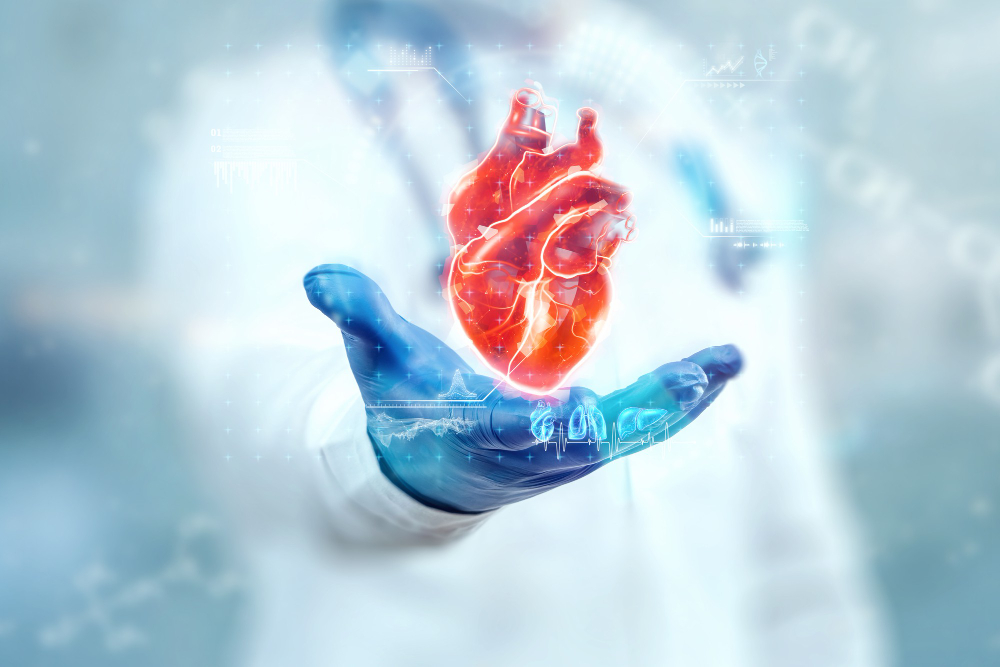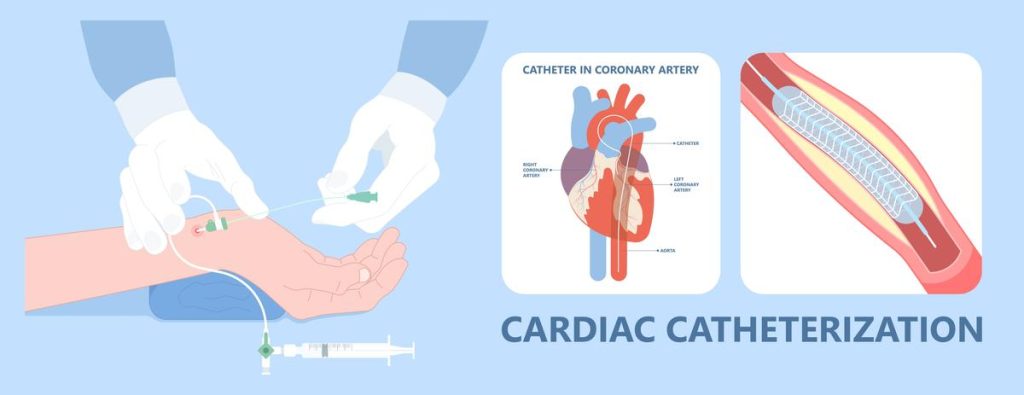Cardiac Catheterization
During a cardiac catheterization, a medical professional inserts a thin tube called a catheter into a blood vessel in your arm or leg and navigates it to your coronary arteries. This procedure is safe and is used as a diagnostic tool to assess the functioning of your heart and determine the necessary course of treatment.

Why might I need cardiac catheterization?
Cardiac cath may be utilized by your doctor for diagnosing these heart conditions.
- A condition known as atherosclerosis occurs when substances such as fatty materials gradually block the arteries within the bloodstream.
- Cardiomyopathy refers to the condition where the heart muscle thickens or weakens, causing an enlargement of the heart.
- Congenital heart disease, also known as congenital heart defects, refers to abnormalities in the heart structures that form during fetal development. Examples include a ventricular septal defect, which is a hole in the wall between the heart’s two lower chambers. Such defects can disrupt normal blood flow within the heart.
- Heart failure is a state where the heart muscle has become insufficiently strong to effectively pump blood, resulting in congestion in the blood vessels and lungs, as well as swelling in the feet, ankles, and other areas of the body.
- Heart valve disease occurs when one or more of the heart valves do not function properly, leading to disruptions in the flow of blood within the heart.
What happens before cardiac catheterization?
Typically, this process is undertaken in a hospital setting. Additionally, individuals will likely undergo blood tests and an EKG. It is also important to consider other factors.
- Before the procedure, the doctor or nurse will provide instructions regarding the food and drink you are allowed or not allowed to consume.
- Inform your doctor of all the medicines, including herbal products and dietary supplements, that you are currently consuming.
- Inquire with your doctor about the medications that are recommended for you to consume on the day of your cardiac catheterization. It is possible that you may have to discontinue certain medications, like Coumadin, which is a blood thinner, a few days prior to the procedure.
- Consult your doctor on how to modify your diabetes medications on the day of your examination if you have diabetes.
- Inform your doctor and nurses about any allergies you have, particularly to iodine, shellfish, X-ray contrast dye, latex, rubber items (such as gloves or balloons), or penicillin-based medications.
- It is possible that you won’t be able to return home the same day as your medical procedure. To ensure your comfort during your stay, remember to bring personal items like a robe, slippers, and toothbrush. Additionally, arrange for someone else to accompany you and provide transportation back home.

What happens during cardiac catheterization?
A specialized doctor carries out the procedure alongside a group of nurses and technicians. The procedure takes place within a hospital’s cardiac catheterization (cath) laboratory.
- Prior to the cath procedure, a nurse will insert an intravenous line into a vein located in your arm. This will allow the administration of a sedative medication to help you feel calm and relaxed. However, it is important to note that you will remain conscious and able to comprehend and comply with instructions throughout the procedure.
- The nurse will proceed to sanitize and trim the region of the body where the doctor will perform their tasks, typically around the pelvic area.
- The needle puncture site is typically numbed with a local anesthetic.
- The physician will insert a needle through your skin and into a sizable blood vessel. Then, a small tube resembling a straw (referred to as a sheath) will be placed into the vessel. The physician will carefully guide a long and slender tube known as a catheter into the vessel through the sheath. A video screen will display the catheter’s movement as it navigates through the main blood vessels towards the heart. You may experience some pressure in your groin area, but you should not experience any discomfort.
- There are several different tools that can be attached to the end of the catheter. These tools can measure the pressure of blood in different chambers of the heart and blood vessels connected to the heart, allow for viewing inside blood vessels, collect blood samples from different areas of the heart, or take a tissue sample (biopsy) from inside the heart.
- Angiography is the term used for the procedure in which a catheter is utilized to administer a contrast dye visible on X-rays.
- Angioplasty or percutaneous coronary intervention (PCI) are the terms used to describe the procedure of using a catheter to open up a narrowed or blocked artery.
- Valvuloplasty is the term used for the procedure of using a catheter to expand a constricted opening in the heart valve.
- The doctor will take out the catheters and the sheath. Your nurse will apply pressure on the area to stop any bleeding. Occasionally, a unique device may be utilized for closing. The whole process typically takes around one hour.

How long does a cardiac catheterization last?
An average cardiac catheterization procedure typically lasts around half an hour (and may extend further if any interventions are required), however, due to the time needed for preparation and recovery, the overall duration of the procedure adds several hours. Therefore, it is advisable to anticipate spending the entire day at the hospital.
What happens after cardiac catheterization?
Afterward, you will be taken to a recovery area where you will have to remain in a horizontal position for a few hours.
- To halt the bleeding, the puncture site will experience the application of pressure.
- You will be required to maintain the straightness of your leg and will be unable to leave the bed.
- During your recovery, medical personnel will monitor your heart rate, pulse, and blood pressure to ensure all vital signs are stable.
- If you experience any swelling, discomfort, or bleeding at the location where the puncture was made, or if you have any chest pain, please notify us.
- Prior to departing the hospital, you will be provided with written guidance on the actions to be taken once you return home.
What happens after I get home?
Make sure to follow the instructions carefully. It is crucial to take your medications as prescribed by your healthcare provider and schedule follow-up appointments before leaving the hospital. Typically, individuals can resume their usual activities the day after the procedure, unless any extra procedures were performed during the cardiac catheterization.
When should I call my healthcare provider?
If you have any of the following symptoms, please get in touch with your healthcare provider:
- Fever.
- Dizziness.
- Discomfort, inflammation, blood loss, or secretion (in a yellow or green color) at the site where the catheter was inserted through your skin.
- Chest pain.
- Shortness of breath.
- Abnormal heart rhythm.
If you believe you are experiencing a heart attack or stroke, get help right away.
Treatment in Türkiye:
The medical staff of surgical teams, doctors and consultants in Rehab Türk can provide the best treatment options and free consultations – by striving to keep abreast of the latest medical technologies and methods.
